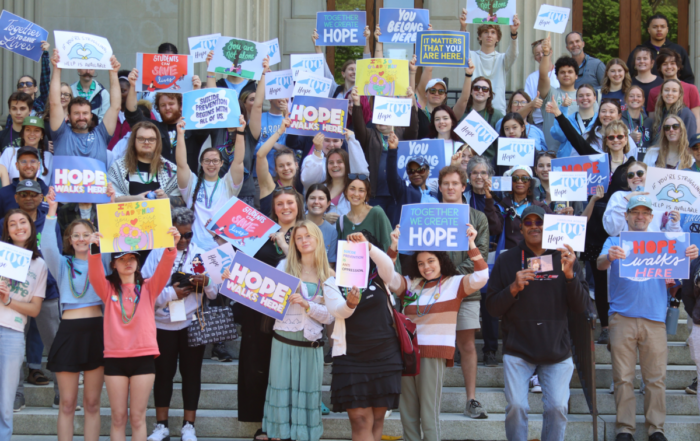Health
Shared Problems, Local Solutions: Understanding Suicide and Prevention in North Carolina
Michael Welker, ncIMPACT Initiative Community Engagement Director
July 19, 2023

Carolina Acros 100 aims to partner with communities as they respond to complex policy challenges created or exacerbated by COVID-19. As we looked for our next program, mental health and suicide quickly emerged as the right issues to address in this moment.
Worsening mental health was one of the most common challenges North Carolinians cited in our initial listening survey at the outset of Carolina Across 100. As we have extended our work across the state, we have continued to hear stories from our community partners about the impacts of mental and behavioral health challenges on North Carolinians and their communities. We have read countless headlines and seen statistics pointing to alarming trends in suicidality and mental health crises. And sadly, the Carolina community has directly experienced the grief and pain that come from lives lost to suicide.
“People don’t really understand who dies by suicide. This is anybody. Anybody can find themselves in a mental health crisis or in a life crisis where they feel like they can’t go on.” – Licensed psychologist
Our State, Our Wellbeing: Partnering to Prevent Suicide in NC will bring together communities across the state with the aim to improve mental and behavioral health supports and ultimately reduce suicides. UNC’s Suicide Prevention Institute will bring their expert knowledge of suicide and mental health as the lead partner in this endeavor.
Before launching Our State, Our Wellbeing, the Carolina Across 100 team spoke to more than a dozen experts from across the state to understand the current landscape and efforts already underway to prevent suicide and improve mental and behavioral health supports in North Carolina. Here’s what we learned.
A Worsening Problem
Many of the experts we spoke to emphasized that suicidality and related issues have been on the rise since before the COVID-19 pandemic. Since the pandemic began, however, rates of suicidality have begun to increase more rapidly.
Across race, age, geography, and other categories, there is no community in North Carolina unaffected by suicide. Many racial and ethnic minorities have seen fast-rising rates of suicidality in recent years. Older people have some of the highest rates of suicide, but many experts we spoke to expressed concern about rapidly worsening mental health and suicidality among youth. Certain populations that are highly concentrated in North Carolina—like people living in rural communities or veterans—have higher rates of suicidality than the broader population.
While the data we have is cause enough for concern, available data may not capture the full scope of the challenge for a few reasons:
This means that for every death or suicide attempt requiring medical care, there may be many more people attempting or thinking of suicide whose needs go undetected.
Existing Statewide Efforts to Respond
Given the seriousness of this issue, policymakers and other leaders are taking steps to reduce suicide and address mental and behavioral health challenges in a variety of ways. Below are just a few examples.
“We need to focus on community-informed practices, not just evidence-based. We need to acknowledge that we’ve missed the boat and not been as attentive to community needs as we should be.” – Public health practitioner
Engaging Trusted Partners is Key
Despite the importance and potential impact of state-level interventions to strengthen prevention efforts and improve mental and behavioral health supports, suicide is ultimately a deeply personal, human issue. Even the most proven strategies may have limited impact if the strategies do not reach the individuals who are most at risk.
Making connections to those individuals can be challenging. Suicide and mental health issues often carry heavy stigma. There are frequently differences across race and ethnicity, age, gender, and other categories in how willing people are to talk about suicide and mental health, how they describe the challenges they face, and how likely they are to seek out help. Even those who do seek help may not be aware of resources or supports that are available in their community or know how to navigate complexities of the mental and behavioral health care system.
Because of this, experts we spoke to emphasized the importance of finding trusted partners in each community beyond the healthcare system to connect people with information, resources, and supports.
These are just a sampling of the ways communities can think creatively and holistically about connecting with those struggling with suicidality to the support they need.

Look to Communities to Lead
Our conversations and research about this work led us to a few clear conclusions. First, the issues of suicide and mental health are shared across the state, but they affect every community differently. In turn, every community brings different assets, resources, and relationships to this challenge. To address this issue effectively, we need local-level input and context alongside coordinated efforts across state-level partners and systems.
These findings both affirmed Carolina Across 100’s commitment to taking on the issue of suicide and shaped how we think about this work. Over the next year, Carolina Across 100 and SPI look forward to bringing stakeholders together around this collective problem and designing, implementing, and evaluating solutions—all within the unique local contexts of communities across North Carolina.
We hope your community will join in this work. You can learn more about Our State, Our Wellbeing on this page or listen to our information session held on July 11. If your community is ready to be a part of this effort, submit your application by July 28.
Our State, Our Wellbeing is the second program of Carolina Across 100, a five-year initiative whose goal is to aid community-driven recovery and build sustainable efforts in all 100 counties by providing human resources, data insights, coaching, facilitation, coordination efforts, and program design.






